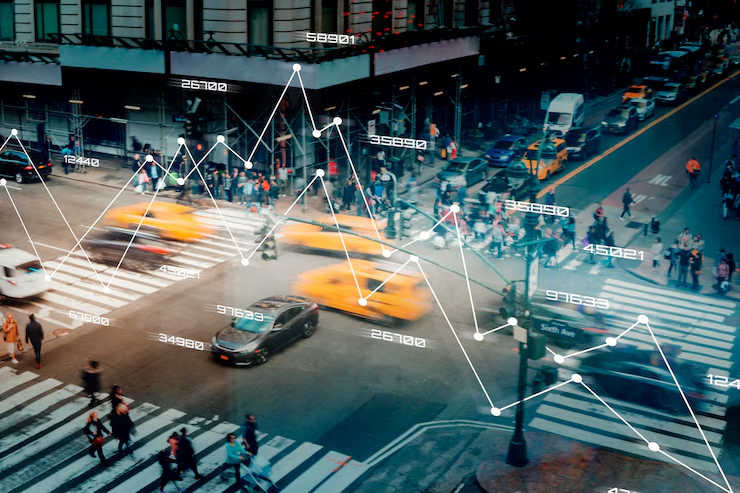The Evolution of Edge Computing in Smart City Infrastructure. Standing at a busy intersection in Barcelona last year, I watched as traffic signals adjusted in real-time to an unexpected surge of pedestrians leaving a local festival. No human operator intervened the intersection’s embedded edge computing system had detected the anomaly, analyzed pedestrian flow patterns, and recalibrated signal timing to prevent congestion. What fascinated me wasn’t just the technology’s effectiveness but how completely invisible it remained to the very citizens benefiting from it.
This seamless intelligence represents the quiet revolution of edge computing in our urban environments a transformation that’s fundamentally changing how smart cities function.
From Cloud Dependence to Edge Intelligence
The journey of smart city computing has been one of progressive decentralization. When cities first began deploying “smart” technologies in the early 2010s, the model was overwhelmingly cloud-centric. Traffic cameras, environmental sensors, and public infrastructure monitors all sent their data to distant data centers for processing. While revolutionary at the time, this approach quickly revealed critical limitations.
A typical cloud-dependent traffic management system would capture video, compress it, transmit it to cloud servers, analyze the footage, generate instructions, and return them to local controllers a process requiring up to 150-200 milliseconds. This delay might seem negligible, but in scenarios involving emergency vehicles or pedestrian safety, these milliseconds matter tremendously.
According to a 2023 study by the Urban Institute, cloud-dependent smart city applications experienced an average of 42 hours of cumulative latency-related service degradation annually—unacceptable for critical urban systems. Something had to change.
The Architectural Shift
The evolution toward edge computing occurred in recognizable phases:
Phase 1: Cloud-First Architecture (2010-2015)
Early smart city initiatives relied almost exclusively on centralized cloud infrastructures. City sensors served primarily as data collection points with minimal local processing. While this enabled the first wave of data-driven urban management, bandwidth constraints and latency issues quickly became apparent.
Phase 2: Fog Computing (2015-2018)
Cities began deploying intermediary processing layers “fog nodes” that handled preliminary data processing before sending refined information to the cloud. This reduced bandwidth consumption by approximately 60% but still created dependencies on connectivity and introduced complex middleware management.
Phase 3: Edge-Native Systems (2018-Present)
Today’s advanced smart cities operate on a principle of “process where produced.” Computational intelligence is embedded directly into streetlights, traffic controllers, waste management systems, and public safety networks. These edge devices make autonomous decisions while sharing only relevant insights with central systems.
Recent implementations have achieved remarkable outcomes:
- 95% reduction in data transmission needs
- Decision latency reduced to 5-10 milliseconds
- 40-65% decrease in overall energy consumption
- Continued functionality during network disruptions
Why the Edge Matters: Beyond Technical Metrics
The significance of edge computing extends far beyond technical performance metrics. It enables entirely new categories of urban innovation:
Contextual Awareness
Edge-enabled infrastructure understands local conditions with unprecedented granularity. A smart streetlight doesn’t just detect motion; it differentiates between a pedestrian, cyclist, or vehicle, adjusting illumination patterns accordingly. This contextual awareness creates more responsive and adaptive urban environments.
Resilience Through Decentralization
When processing is distributed across thousands of edge nodes rather than concentrated in centralized data centers, the failure of any single component has minimal impact. During a 2022 regional server outage in Singapore, edge-enabled traffic systems continued operating autonomously for 7 hours while cloud-dependent systems failed.
Privacy by Design
Edge computing fundamentally alters the data governance equation. When facial recognition cameras process images locally and transmit only anonymized metadata rather than raw video feeds, they inherently enhance privacy. Personal data never leaves the collection point, dramatically reducing exposure risks.
Transformative Applications Reshaping Urban Life
The most compelling evidence of edge computing’s impact comes from its real-world applications:
Intelligent Intersections
Modern smart intersections equipped with edge processors analyze up to 15 video feeds simultaneously to detect vehicles, pedestrians, cyclists, and anomalies. Instead of following fixed timing patterns, these intersections continuously recalibrate based on actual conditions. Cities implementing these systems have reported 17-23% reductions in average wait times and 12-15% decreases in emissions from idling vehicles.
Adaptive Urban Lighting
Edge-powered lighting networks adjust brightness based on pedestrian presence, weather conditions, and ambient light levels. Beyond energy savings (typically 35-50%), these systems create dynamic lighting environments that enhance public safety while reducing light pollution.
Emergency Response Optimization
When integrated with public safety systems, edge networks create real-time emergency response corridors by progressively adjusting traffic signals along critical routes. This coordination happens locally without central server dependencies, reducing emergency vehicle travel times by an average of 23%.
Environmental Monitoring and Response
Distributed environmental sensors with edge capabilities don’t just measure pollution—they trigger immediate interventions. In Seoul’s smart districts, high particulate matter readings automatically adjust ventilation systems in nearby public buildings and trigger alerts to vulnerable populations within specific affected areas.
The 5G Multiplier Effect
The rollout of 5G networks is dramatically accelerating edge computing adoption through three key mechanisms:
- Network Slicing: 5G allows cities to create dedicated virtual networks for critical services, ensuring bandwidth for essential edge applications even during network congestion.
- Ultra-Reliable Low-Latency Communication (URLLC): This 5G capability guarantees sub-millisecond communication between edge nodes, enabling synchronized responses across distributed systems.
- Massive Machine Type Communication (mMTC): 5G networks can support up to one million connected devices per square kilometer—an order of magnitude increase that allows for much finer-grained sensing and response.
This synergy between 5G and edge computing is expected to generate $17.8 billion in smart city technology investment by 2026, according to recent industry forecasts.
Conclusion: The Invisible Intelligence
The most successful technologies often become invisible so seamlessly integrated into our environment that we barely notice their presence. Edge computing is following this path in smart city development, fading into the background while fundamentally transforming urban experiences.
What makes edge computing truly revolutionary isn’t the technology itself but how it shifts the relationship between citizens and urban systems. When infrastructure can sense, analyze, and respond at the local level, cities become more than collections of smart devices they become living, adaptive environments attuned to human needs.
The future of smart cities doesn’t lie in more centralized control but in distributed intelligence that operates silently at the edges processing countless local interactions to create safer, more efficient, and more sustainable urban experiences. The true potential of edge computing isn’t measured in milliseconds saved or bandwidth conserved, but in seamless urban experiences that wouldn’t otherwise be possible.

